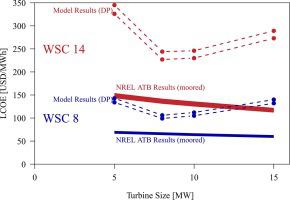当前位置:
X-MOL 学术
›
Energy Convers. Manag.
›
论文详情
Our official English website, www.x-mol.net, welcomes your feedback! (Note: you will need to create a separate account there.)
Assessing the costs and benefits of dynamically positioned floating wind turbines to enable expanded deployment
Energy Conversion and Management ( IF 10.4 ) Pub Date : 2024-03-16 , DOI: 10.1016/j.enconman.2024.118301 Rudolph Santarromana , Ahmed Abdulla , Joana Mendonça , M. Granger Morgan , Massamiliano Russo , Rune Haakonsen
Energy Conversion and Management ( IF 10.4 ) Pub Date : 2024-03-16 , DOI: 10.1016/j.enconman.2024.118301 Rudolph Santarromana , Ahmed Abdulla , Joana Mendonça , M. Granger Morgan , Massamiliano Russo , Rune Haakonsen

|
In addition to technical and economic challenges, the offshore wind industry must also contend with environmental and socio-political concerns that constrain development. Here, the viability of dynamically positioned floating offshore wind platforms that could ameliorate these constraints is analyzed. Such a design can unlock deeper, less-contentious waters that are farther from shore and reduce environmental interactions in the ocean, thus expanding and improving deployment opportunities. While prior studies on this application only focused on energy performance, the resulting cost of energy and benefits have not yet been quantified. Although prior studies found that the energy-performance of this strategy does not show promise, it is possible that a full understanding of the costs and benefits will reveal a decision space where it makes sense. To address this gap in the literature, the cost penalty of this application compared to moored turbines is estimated here. A physical engineering model is used to compute the environmental loads on a floating offshore wind turbine to estimate the expected energy needed by the station-keeping thrusters and one potential environmental benefit—eliminated mooring chains. The models were validated using marine engineering simulation software. Dynamic positioning realizes a cost penalty of at least 30 U.S. dollars/megawatt-hour while eliminating up to 900 km of mooring chains for a 1-gigawatt array. Up to 3 megawatt-hours of stored energy are needed to station-keep during continuous low winds. Furthermore, dynamic positioning is more viable for turbines of intermediate size (8–10 MW) rather than larger turbines (15 MW). The results show that aerodynamic loads on the turbine fall sharply beyond the rated wind speed, operational and design improvements may further improve the viability of this application, and the energy performance of this application continually improves with added thrusters although the cost of energy does not.
中文翻译:

评估动态定位浮动风力涡轮机的成本和效益,以实现扩大部署
除了技术和经济挑战外,海上风电行业还必须应对制约发展的环境和社会政治问题。在这里,分析了可以改善这些限制的动态定位浮动海上风电平台的可行性。这种设计可以释放距离海岸较远、争议较小的更深水域,并减少海洋中的环境相互作用,从而扩大和改善部署机会。虽然之前对该应用的研究仅关注能源性能,但由此产生的能源成本和效益尚未量化。尽管之前的研究发现该策略的能源绩效并未显示出希望,但对成本和收益的全面了解可能会揭示出有意义的决策空间。为了解决文献中的这一差距,这里估计了该应用与系泊涡轮机相比的成本损失。物理工程模型用于计算浮动海上风力涡轮机上的环境载荷,以估计位置保持推进器所需的预期能量以及一项潜在的环境效益——消除系泊链。使用海洋工程仿真软件对模型进行了验证。动态定位可实现至少 30 美元/兆瓦时的成本损失,同时消除 1 吉瓦阵列长达 900 公里的系泊链。在持续低风期间,需要多达 3 兆瓦时的存储能量来保持驻地。此外,动态定位对于中等尺寸(8-10 MW)的涡轮机比大型涡轮机(15 MW)更可行。结果表明,涡轮机上的空气动力载荷急剧下降,超过额定风速,操作和设计改进可能会进一步提高该应用的可行性,并且该应用的能源性能随着增加的推进器而不断提高,尽管能源成本并未提高。
更新日期:2024-03-16
中文翻译:

评估动态定位浮动风力涡轮机的成本和效益,以实现扩大部署
除了技术和经济挑战外,海上风电行业还必须应对制约发展的环境和社会政治问题。在这里,分析了可以改善这些限制的动态定位浮动海上风电平台的可行性。这种设计可以释放距离海岸较远、争议较小的更深水域,并减少海洋中的环境相互作用,从而扩大和改善部署机会。虽然之前对该应用的研究仅关注能源性能,但由此产生的能源成本和效益尚未量化。尽管之前的研究发现该策略的能源绩效并未显示出希望,但对成本和收益的全面了解可能会揭示出有意义的决策空间。为了解决文献中的这一差距,这里估计了该应用与系泊涡轮机相比的成本损失。物理工程模型用于计算浮动海上风力涡轮机上的环境载荷,以估计位置保持推进器所需的预期能量以及一项潜在的环境效益——消除系泊链。使用海洋工程仿真软件对模型进行了验证。动态定位可实现至少 30 美元/兆瓦时的成本损失,同时消除 1 吉瓦阵列长达 900 公里的系泊链。在持续低风期间,需要多达 3 兆瓦时的存储能量来保持驻地。此外,动态定位对于中等尺寸(8-10 MW)的涡轮机比大型涡轮机(15 MW)更可行。结果表明,涡轮机上的空气动力载荷急剧下降,超过额定风速,操作和设计改进可能会进一步提高该应用的可行性,并且该应用的能源性能随着增加的推进器而不断提高,尽管能源成本并未提高。



























 京公网安备 11010802027423号
京公网安备 11010802027423号